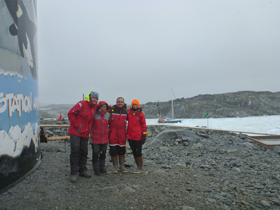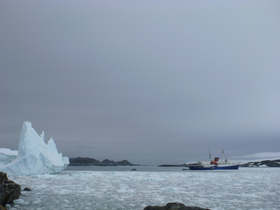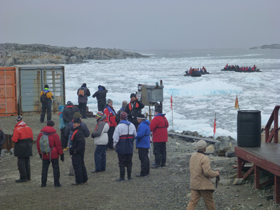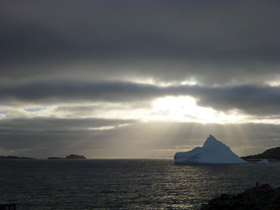
If you have been checking out the Palmer Station webcam (http://www.usap.gov/videoclipsandmaps/palWebCam.cfm) recently you may have noticed that we have been having a wide variety of visitors lately. The type of visitor and duration of stay have varied greatly, mostly the length of stay has depended on the weather. Our visitors have ranged from a 12 meter (39.4 ft) long sailboat to giant icebergs and small cruise ships.
On Monday of this week, the S/Y (sailing yacht) Quijote stopped by for a visit (that was the sailboat visitor). The morning after their arrival, anyone at Palmer interested in learning more about Quijote was invited out to the boat for a tour. I jumped at the chance for a visit after hearing that the couple that owned the Quijote also built her. I was really curious about the process and effort that would go into a colossal project like building a sailboat and travelling to Antarctica. Plus, we sometimes get to go out on some of the ships that visit the Palmer area and give talks about the work we do here at Palmer and this seemed like a neat opportunity.
All four of Quijote’s crew warmly welcomed a small group of Palmerites (one of the nicknames for residents of Palmer station) aboard Quijote after we pushed our way through the densely packed brash ice that had blown into Hero Inlet (where Quijote was secured, about 100 ft from the Palmer boat dock). Quijote arrived in our neck of the woods with her “parents” (Fede and Laura) and two of their friends (Erik and Pato).
We (Kevin, Bill (a Palmer LTER Principle Investigator), Dave (the Boating Coordinator), Nandi (waste specialist extraordinaire), and I) were quickly impressed by Quijote’s surprisingly spacious and cleverly designed deck and below decks living areas. Fede designed and basically built Quijote in his back yard, we even got to see pictures of the whole process unfolding. It was very impressive. After a tour, Quijote’s crew followed us back to Palmer Station for a tour of our home. It seemed only fitting after they had so generously opened their home to us.
During the tour of station, not dissimilar to the one described in Maggie’s last entry, I asked the crew what they had learned from their trip so far. The number one thing was the importance of flexibility. If you are interested in more of their adventures, they are chronicling their voyage at http://www.syquijote.com, they even describe their visit to Palmer Station.
Following the mutual visits between Quijote crew and Palmer station residents, the weather turned cloudy and blustery. That brought our next visitors. We got two at the same time. One was a giant iceberg that anchored itself just off a rocky spit near the dock called Gamage Point. The other visitor was the cruise ship Ushuaia, an Argentinian cruise ship, and the last cruise ship scheduled to stop by this season.

There is a great outreach tradition here at Palmer Station and as such, passengers from the Ushuaia were invited to come to Palmer Station for a tour to learn more about the scientific activities here. We got to meet folks from many of the groups, with a wide variety of backgrounds while we were working on setting up our apparatus for microcosm ocean acidification experiments (LOTS more on that later…). Folks from the groups asked lots of great questions!
Tours of station are given by a lot of science support folks. All tours end in the galley, which is transformed into an information center, with posters describing all of the science that goes on at Palmer throughout the year (and includes trays brimming with the station’s famously delicious brownies). This is also where we showcased in make shift aquaria some of the benthic (things that live on the ocean bottom) organisms we have been collecting. Included for viewing were both macroalgae (seaweeds) and invertebrates that are common around Palmer Station, such as some small red algae, snails, isopods, and brittle stars (to name a few of the critters).

This visit was a very different from that of the Quijote. I am always impressed by how well organized everything has to be to ensure that 150 people get a chance to get a good feeling for all of the work that goes on here. There was a lot less structure to the visit when there were only 4 people to coordinate. Visits are always high energy and educational experiences, not just for our visitors but for those folks like us living here at Palmer. This becomes a particularly prominent and important part of Palmer Station life during the Antarctic summers (because that is when the cruise ships can make it down here safely).
That brings us to the end of the week. All of our visitors have now departed, well all except those icebergs. They are continuing to slowly move so they get a closer view of Palmer Station. Our new iceberg neighbors certainly add new character to our regular view.

On Saturday we will have our last visitor for the week. The HMS Protector will be stopping by. The Protector has stopped by several times so far this season and has been helping with updating surveys of the waters around Palmer. It should be another interesting visit. So as you can see, we are lucky to not be as isolated as many of the other Antarctic research stations and get to share our research here with a wide variety of adventurers.